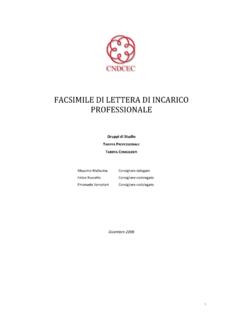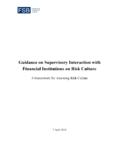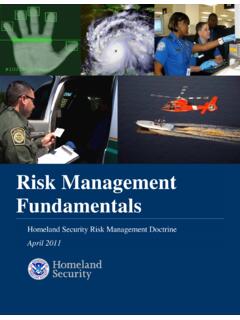Transcription of Sample Enterprise Risk Management Framework
1 Sample Enterprise Risk Management Framework Definition Enterprise Risk Management enhances an organization's ability to effectively manage uncertainty. It is a comprehensive, systematic approach for helping all organizations, regardless of size or mission, to identify events, and measure, prioritize and respond to the risks challenging its most critical objectives and related projects, initiatives and day-to-day operating practices. 3. Sample Enterprise Risk Management Framework Enterprise RISK Management POLICY. Corporate-wide Vision XYZ is committed to its vision, which is to be the most preferred and successful telecommunications group. In achieving this vision, XYZ will face risks to its business strategy, operational risks and risks associated with the protection of its people, property and reputation. This document describes the policies by which the entire spectrum of these risk are to be effectively managed.
2 Enterprise Risk Management Policy XYZ defines risk as any potential event which could prevent the achievement of an objective. It is measured in terms of impact and likelihood. risks arise as much from the likelihood that an opportunity will not happen, as it does from the threat or uncertainty that something bad will happen. XYZ's policy is to identify, analyse and respond appropriately to all risks . The risk responses selected are determined by the appetites and tolerances for risks . These will vary over time according to the specific business objectives, for example strategic, operational or asset protection. The effectiveness of risk Management and control measures will be regularly reported to and acted upon by the Board. In addition, periodic independent review on the effectiveness will be conducted. Responsibilities The Board is responsible for the Enterprise Risk Management Framework . The Senior Leadership Team under the leadership of the Chief Executive Officer is responsible for implementing the strategy, culture, people, processes, technology and structures which constitute the Enterprise Risk Management Framework .
3 Review of policy This policy and underlying principles will be reviewed annually by the Board, to ensure its continued application and relevance. Key Principles on Managing Risk In order to achieve XYZ's business objectives, risks must be considered and managed Enterprise -wide;. Risk Management is integral to the strategic planning process, business decision making and day-to-day operations;. risks are identified, analysed, responded to, monitored and reported on, in accordance with XYZ's policies and procedures;. Risk responses must be tailored to each particular business circumstance;. Management must regularly assess the status of risks and risk responses; and Compliance with the Enterprise Risk Management Framework must be monitored and reported. 4. Sample Enterprise Risk Management Framework XYZ's Enterprise RISK Management APROACH. XYZ has adopted the ORCA Approach to ensure consistent application of risk Management by all staff, in the: execution of strategy, achievement of business objectives, and day-to-day operations.
4 ORCA represents: O OBJECTIVES. Goals and results that XYZ aims to achieve R risks . Any potential event which could prevent the achievement of an objective C CONTROL. Management 's response to risks A ALIGNMENT. Alignment of XYZ's objectives, risks and controls across the Enterprise determined by its appetites and tolerances for risks XYZ's Enterprise RISK Management PROCESS. The XYZ Enterprise Risk Management process Objectives comprises the following steps: Understand & Confirm Business 1 IDENTIFY key risks 2 ANALYSE the potential impact and likelihood of risks Identify 3 RESPOND to risks by considering existing controls as well as selecting, prioritising and implementing appropriate actions Analyse Report XYZ's Risk 4 MONITOR the internal and external environment for potential changes to risks Management and ensure that risk responses continue to Process operate effectively 5 REPORT on risks and the status of risk responses adopted Respond Monitor Risk and Controls 5.
5 Sample Enterprise Risk Management Framework OBJECTIVES. What we are trying to achieve in our business? XYZ's MISSION XYZ's VISION. To be the most preferred and successful To exceed customer, shareholder and communications group in Europe. employee expectations by providing superior customer and shareholder value and being the employer of choice XYZ's BUSINESS OBJECTIVES. XYZ's business objectives drive its activities, and hence the business objectives should be clearly defined and communicated. The Enterprise risk Management Framework starts with the understanding of the business objectives in ensuring that key risks are identified. Enhance Premium Brand;. Sustain Operational Excellence;. Continue Quality Customer Service;. Develop Strategic Partership;. Improve human capital;. Improve Product leadership and innovation;. Develop Quality network;. Improve Targeted and Profitable growth. XYZ PLANNING AND COMMUNICATIONS.
6 Mission Vision Risk Management begins by: Identifying the stakeholders, as different stakeholders' needs must be recognised and satisfied to varying degrees. Business Objectives Understanding and confirming key objectives, strategic, business, divisional and departmental, process and project objectives. Communicating pertinent information in a Day-to-day Operations form and within a timeframe that and Decision Making facilitates Management decision-making and day-to-day operations Processes Divisions & Projects Departments 6. Sample Enterprise Risk Management Framework risks . What could affect your ability to meet objectives? risks are uncertain future events which could influence the achievement of XYZ business objectives and can be viewed from three perspectives: Opportunity Risk of lost opportunity or something good not happening By viewing risks from the perspective of opportunity, XYZ recognises the inherent relationship between risk and return, the greater the risk, the greater the potential return or loss.
7 In this context, XYZ must adopt suitable responses to maximise the upside opportunity within the constraints of its operating environment. Typically, strategic questions will involve consideration of this type of risks . Uncertainty Risk of not meeting expectations When considering risks from the perspective of uncertainty, XYZ must determine how it can proactively prevent an uncertainty from having a negative impact. This will mainly be achieved through Management of risks relating to operational performance. Hazard Risk of loss or something bad happening While managing risk from the perspective of hazard, XYZ must mitigate the degree of damage to critical business assets (people, property, earning capacity and reputation) that would be caused if the hazard occurs. Risk Appetite and Risk Tolerance XYZ business objectives are integral to its appetites for, and tolerances of, risk. The risk appetites and tolerances dictate the nature and level of risks that are acceptable to XYZ.
8 Risk appetite is defined as the risks that XYZ is in business to take, based on its corporate goals and its strategic imperatives.'. Risk tolerance represents the threshold of risk that XYZ considers acceptable, based on its capabilities to manage the identified risks '. Risk appetites and tolerances will vary according to the balance of opportunity, uncertainty or hazard which differing risks represent. 7. Sample Enterprise Risk Management Framework CONTROL. Which risk responses promote the achievement of objectives? Control encompasses all of XYZ's possible responses to risk, whether viewed as opportunities, uncertainties or hazards. These controls are the responsibilities of all XYZ staff and are designed to provide reasonable assurance regarding the achievement of XYZ business objectives. In determining risk responses, XYZ must first assess whether to accept, exploit, mitigate, transfer or avoid the risks .
9 In the case of exploit, mitigate or avoid, controls will need to be put in place. There are three main categories of controls: Preventive Controls Responses to stop undesirable transactions, events, errors or incidents occurring Detective Controls Responses to promptly reveal undesirable transactions, events, errors or incidents so that appropriate action can be taken Corrective Controls Responses to reduce the consequences or damage arising from crystallisation of a significant incident In determining the types of controls to be implemented, the following factors are considered: XYZ's business objectives XYZ's capability and skills Appetite and tolerance for the type of risk Time horizon matching the duration of the exposure and the length of time required in implementing solutions to manage the risks Financing cost effectiveness Alignment with other initiatives within the organisation and overall business direction In ensuring the effectiveness of controls, the following factors are essential: Control Framework is the responsibility of the Board of Directors Integrity, ethical values and competencies of XYZ staff Management 's philosophy and operating style Delegation of authority and responsibility Continuous staff development Incorporate in existing infrastructure, business processes and reporting as far as possible 8.
10 Sample Enterprise Risk Management Framework ALIGNMENT. ALIGNMENT. Are objectives, risks and controls aligned Enterprise -wide? Alignment exists between the objectives, risks and controls at all levels within XYZ: Between strategies, operational objectives and individual job accountabilities Between the risks being taken and the XYZ's appetite and tolerance for risk Between the control and the desired level of investment in implementing such control Given the fast and continuous change in today's business environment, XYZ's competitive advantage is dependent on the rapid deployment of new strategies, whilst remaining focused on existing strategies. In order to achieve the above, XYZ must therefore streamline the actions of all staff, individually and collectively towards achieving its business objectives. This entails the alignment of the objectives, risks and controls throughout the Enterprise . It should encompass the respective business processes and operational activities undertaken by all levels of staff.











